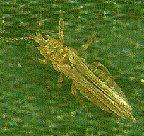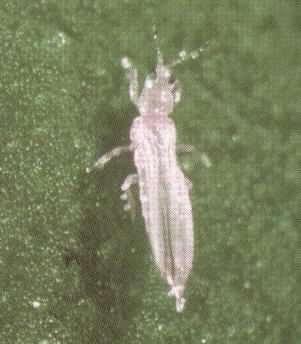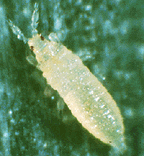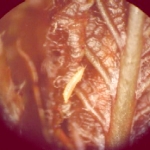





Thrips
Description
Thrips are tiny insects which measure about 1/50 inch. While the most common species known to feed on African Violets is yellow in color, they may also be brown or black. Thrips thrive on the flowers and leaves of African Violets, especially the underside of the leaves. Because of their very small size, you may not see them unless you are using a magnifying glass. For this reason, your first clue that Thrips are present will probably be the light yellow powder which Thrips leave on the flowers. This is actually pollen which has been spilled from the anthers as they feed on the flowers. If left untreated, Thrips can cause severe damage to African Violets.
Of those Thrips known to feed on African Violets, the most common species is Frankliniella occidentalis.
Distinguishing Symptoms
Note: While it is important to distinguish pollen left by Thrips from pollen left by Earwigs (see above), it is also important to distinguish pollen left by Thrips from pollen which has naturally spilled from mature blossoms. Therefore, check the underside of the leaves for silver or gray streaks. If your Violet has both of these symptoms, it probably has Thrips. To be sure, hold some of the Violet's flowers over a sheet of paper and give them a gentle thump. If Thrips are present, you will see some of them drop onto the paper. You may need a magnifying glass to correctly identify them.
Other Symptoms
Treatment
Some advise using Malathion to treat Thrips. This may be effective on some species of Thrips, but the most common species is resistant to Malathion. Also, Malathion may discolor the flowers of Violets. A more reliable treatment employs Acephate, a common ingredient in household insect sprays. Acephate sprays of this type, however, may damage foliage due to a specific additive found in these sprays. As an effective alternative, use a soluble powder, and mix your own spray. Be sure to spray all of your Violets, not just those which currently exhibit symptoms. Thrips spread quickly, so if even one Violet has them, all are at risk. After this initial application, spray twice more at seven day intervals. This will rid your Violets of any unhatched Thrips which may not have been affected by your first application.
As an alternative to traditional chemical treatments, try spraying with Neem (Azadirachtin). Neem is a substance which has natural insecticidal properties, and according to currently available research, it is biodegradable and non-toxic. When sprayed on African Violets, it discourages Thrips by making the plant unpalatable. Though Neem does have some systemic effect in plants, spray it as you would other contact insecticides, being sure to spray in areas where Thrips are known to cluster.
Finally, remove all flowers and buds from your Violets. This procedure has been shown to significantly enhance the effectiveness of the treatment, whether spraying with Acephate or Neem.
Prevention
After working outdoors, always change clothes before handling indoor plants. Always wash hands before handling your Violets, and keep pets away. Finally, keep in mind that Thrips are very small. They also fly. A typical screen, such as one might put on a window or door, may not prevent Thrips from getting indoors.
Important Note on the Use of Pesticides
Please note that almost all pesticides are formulated for specific uses and conditions. When applied incorrectly, pesticides can cause ill health or damage to plants. Therefore, when using any kind of pesticide or chemical treatment, always apply as indicated on the product label.
 |
| Begin New Diagnosis |
| Doctor Optimara Main Page | Glossary of Violet Terms | Contact Optimara |
| Pests, Pathogens and Cultural Problems (Complete List) |
Copyright 1999 Optimara/Holtkamp Greenhouses, Inc. Nashville, Tennessee. Doctor Optimara is a trademark of Holtkamp Greenhouses, Inc. Optimara and the Optimara logo are trademarks of International Plant Breeding, A.G., Switzerland.